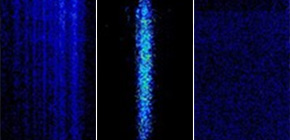
An atomic laser with the world's shortest wavelength achieved
Ideal X-ray laser produced from copper foil
A group of researchers from The University of Electro-Communications, RIKEN, Japan Synchrotron Radiation Research Institute, The University of Tokyo, Osaka University, and Kyoto University found that by using the technology of the world's most advanced X-ray free electron laser (XFEL), SACLA, copper foil used for ordinary electrical wiring was able to produce an ideal X-ray laser -- a world first. This is the atomic laser with the shortest wavelength in the hard X-ray region.
There are two types of methods for producing lasers: a method using energy level differences in an atom or molecule (atomic/molecular level laser) and a method using free electrons in a vacuum (free electron laser). The former method is used in the visible to near-infrared area, but its application in the short wavelength region, including the X-ray region, was difficult.
On the other hand, in principle, the latter method has no constraint in wavelength. Thanks to recent technological developments, XFEL such as SACLA have achieved great results; however, because of the optical features of atomic lasers, its usage in this wavelength region has been greatly sought after.
In order to achieve an atomic laser in the X-ray region, of the electrons surrounding the atom, electrons closest to the atomic nucleus need to be removed efficiently. By making use of the two-stage reflective focusing system installed in SACLA, this group succeeded in generating such a situation.
This group also succeeded in emitting an ideal atomic laser called “Fourier transform limit,” by simultaneously entering other weak X-rays produced by SACLA to this medium. The wavelength of 1.5 ångströms of this atomic laser is very short, one tenth of the conventional one. This group achieved an atomic laser in the hard X-ray region for the first time in the world.
Stimulated emission in which atoms can be controlled by light is used during this process. It was observed in the X-ray region for the first time that even the rules of energy in an atom, which are determined by nature, can be changed.
This group achieved technology for emitting an X-ray laser with different wavelengths from various atoms through simply irradiating small materials with XFEL. This result will likely facilitate research on applications for an X-ray laser with high functionality.
Abstract
Since the invention of the first lasers in the visible-light region, research has aimed to produce short-wavelength lasers that generate coherent X-rays; the shorter the wavelength, the better the imaging resolution of the laser and the shorter the pulse duration, leading to better temporal resolution in probe measurements. Recently, free-electron lasers based on self-amplified spontaneous emission have made it possible to generate a hard-X-ray laser (that is, the photon energy is of the order of ten kiloelectronvolts) in an ångström-wavelength regime, enabling advances in fields from ultrafast X-ray spectrosopy to X-ray quantum optics. An atomic laser based on neon atoms and pumped by a soft-X-ray (that is, a photon energy of less than one kiloelectronvolt) free-electron laser has been achieved at a wavelength of 14 nanometres. Here, we use a copper target and report a hard-X-ray inner-shell atomic laser operating at a wavelength of 1.5 ångströms. X-ray free-electron laser pulses with an intensity of about 10 19 watts per square centimetre tuned to the copper K-absorption edge produced sufficient population inversion to generate strong amplified spontaneous emission on the copper Kα lines. Furthermore, we operated the X-ray free-electron laser source in a two-colour mode9, with one colour tuned for pumping and the other for the seed (starting) light for the laser.
Figure 1
Figure 2
Figure 3
Figure 4
To learn more about this research, please view the full research report entitled " Atomic inner-shell laser at 1.5-ångström wavelength pumped by an X-ray free-electron laser " at this page of the Nature website.
Related link
